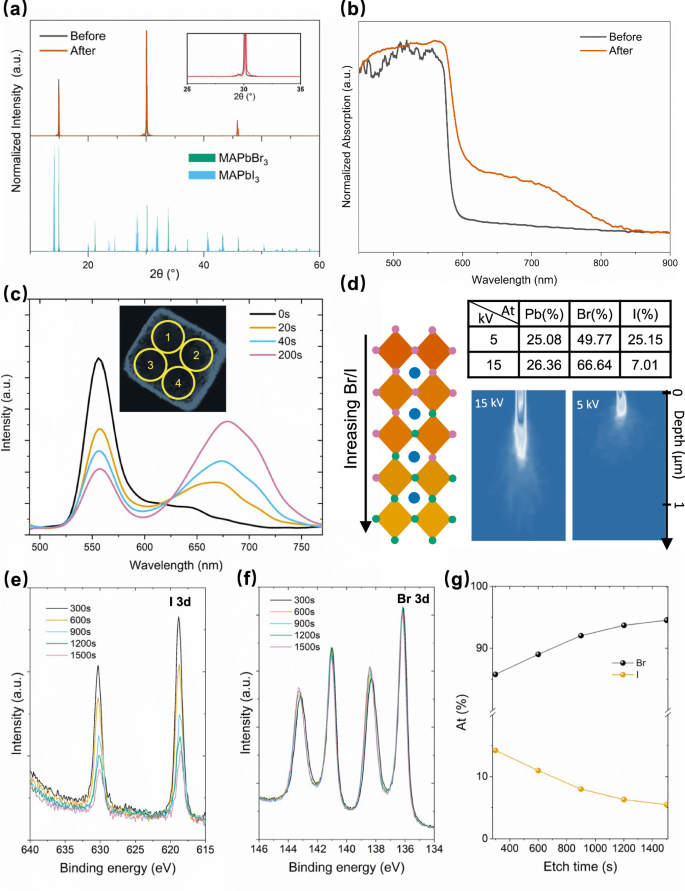Energy-band gradient structure originated from longitudinal phase segregation of mixed halide perovskite single crystal
IF 7.5
Q1 MATERIALS SCIENCE, MULTIDISCIPLINARY
引用次数: 0
Abstract
Energy-band gradient halide perovskites are highly desired candidates for fabricating high performance optoelectronic devices. Here, we demonstrate that a mixed halide perovskite single crystal undergoes phase segregation in the longitudinal direction under above-bandgap light illumination. As a result, a micron thick layer with vertically gradient halide composition and thus graded valence band edge is generated at the crystal surface. The resultant gradient structure can facilitate the hole extraction at its interface with a hole transport layer. The longitudinal phase segregation of mixed halide perovskite single crystal is likely driven by abundant defects at the surface. Moreover, the segregation rate is increased in air compared to nitrogen probably due to the combined effect of oxygen and moisture. These findings not only deepen the understanding of phase segregation mechanism in mixed halide perovskite, but also indicate a promising avenue of fabricating vertically energy-band gradient perovskite and enhancing the perovskite-based optoelectronic device performance. Energy-band gradient halide perovskites are highly desired candidates for fabricating high performance optoelectronic devices. Here, it is shown that a mixed halide perovskite single crystal undergoes phase segregation in the longitudinal direction under abovebandgap light illumination, generating a micron-thick layer with vertically gradient halide composition and thus graded valence band edge at the crystal surface.


混合卤化物包光体单晶纵向相分离产生的能带梯度结构
能带梯度卤化物包晶是制造高性能光电器件的理想候选材料。在这里,我们证明了混合卤化物包光体单晶在高带隙光照射下会发生纵向相分离。因此,在晶体表面产生了一个微米厚的层,该层具有垂直梯度卤化物成分,因而具有梯度价带边。由此产生的梯度结构可在其与空穴传输层的界面上促进空穴萃取。混合卤化物包光体单晶的纵向相分离可能是由表面丰富的缺陷驱动的。此外,与氮气相比,空气中的偏析率更高,这可能是由于氧气和水分的共同作用。这些发现不仅加深了人们对混合卤化物包晶石中相偏析机制的理解,而且为制备垂直能带梯度包晶石和提高基于包晶石的光电器件性能指出了一条大有可为的途径。能带梯度卤化物包晶是制造高性能光电器件的理想候选材料。这里的研究表明,在高带隙光的照射下,混合卤化物包光体单晶在纵向发生相分离,在晶体表面产生微米厚的具有垂直梯度卤化物成分的层,从而形成梯度价带边。
本文章由计算机程序翻译,如有差异,请以英文原文为准。
求助全文
约1分钟内获得全文
求助全文
来源期刊

Communications Materials
MATERIALS SCIENCE, MULTIDISCIPLINARY-
CiteScore
12.10
自引率
1.30%
发文量
85
审稿时长
17 weeks
期刊介绍:
Communications Materials, a selective open access journal within Nature Portfolio, is dedicated to publishing top-tier research, reviews, and commentary across all facets of materials science. The journal showcases significant advancements in specialized research areas, encompassing both fundamental and applied studies. Serving as an open access option for materials sciences, Communications Materials applies less stringent criteria for impact and significance compared to Nature-branded journals, including Nature Communications.
 求助内容:
求助内容: 应助结果提醒方式:
应助结果提醒方式:


